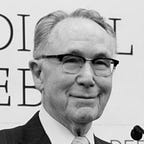Medical Debt Forgiveness Drives are Not Enough and Also Not Good. Says Who?
Remarkably, given the subject matter which debates the value of medical debt forgiveness, this article in Current Affairs by Dr. Luke Messac, an attending emergency physician at Brigham and Women’s Hospital in Boston and author of Your Money or Your Life, is as fair and well-balanced as could be hoped.
The hard work of the early Occupy Movement through the Rolling Jubilee and later by the charity I co-founded with industry partner Craig Antico in 2014 — RIP Medical Debt — is well documented and Dr. Messac’s research and interview efforts are excellent. I speak of the latter from experience.
Occupy and RIP by pioneering medical debt cancellation have done the most important thing possible — bringing to public attention the evils of a broken medical system and its horrific economic effects on Americans. Subsequent work by RIP in particular over the past 10+ years has propelled that subject into front-page headlines. Americans, awakened and outraged, are storming the castle.
So, what’s the problem?
At question is the article’s contention, as voiced by some in the Rolling Jubilee, that medical debt forgiveness is a false solution as it “subsidizes” the debt collection industry and the hospitals where this debt is generated. (It is from these two entities that RIP purchases the debt which it forgives). The thought is that the more debt that RIP purchases, the more encouraged hospitals are to turn more patients into debtors.
That’s like saying if you were to arrive at the site of a train wreck and stop to help the injured you would be encouraging railroads to have more accidents. Hello?
What happens in truth is that the medical debt RIP purchase — all of it uncollectible and already written off the books — does not encourage the creation of more debt buyers or motivate more hospitals to put more patients into collection. Quite the opposite.
RIP Medical Debt, Craig Antico and I have purposefully and consciously motivated the debt-buying industry to be more responsible by bringing their practices to light, for hospitals to rethink their charity policies and extend charity to more patients, and even for credit bureaus to remove medical debt marks.
If our critics want policy changes to reduce debt creation, nothing beats public awareness as both a goad and a disinfectant. Just Google RIP Medical Debt and scan the headlines and read the countless articles and broadcast interviews castigating industry predators.
Who’s to thank?
For that outpouring of anger, RIP salutes the hundreds of organizations, donors, and supporters who further our work through local and national campaigns. Americans have arrived at the train wreck, and they don’t like it one bit. That’s why our charity is so popular; it’s committed, loud, and professional at what we do.
This year alone through August, 1,426,088 individuals have been relieved of $1,705,479,387.68 in medical debt. From our launch in January 2014: 6,919,036 individuals have seen $10,225,627,032.23 in their medical debt forgiven.
So, thank you Dr. Messac for bringing RIP and Occupy’s work to your readers’ attention; I’m sure that both organizations will put to good use the increased donations that will naturally occur from this publicity.
Next reporter, please.
